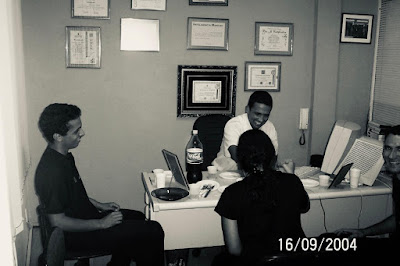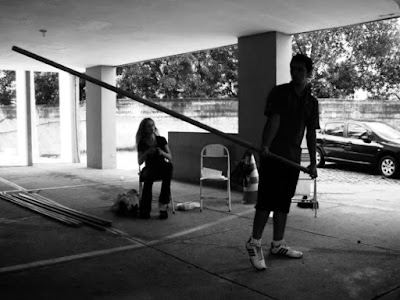[Com Si Fu em seu aniversário de 2004 antes de minha
primeira demonstração de Ving Tsun pública.]
Lembro quando em 1991 entrei em uma nova vide locadora numa sobreloja de uma das esquinas da Rua dos Topázios em Rocha Miranda. Eu segurava um saquinho de papel branco, de uma batata chips daquelas bem gordurosas, que um rapaz vendia nesta rua e que preparava com óleo de procedência duvidosa. Quando entrei na loja com minha mãe, senti um delicioso cheiro de talco. Em seguida, fomos muito bem recebidos pela dona da locadora, e achei divertido o fato de minha ficha ser a número 02(Eu era o segundo cliente! Quem iria acreditar?). Resolvi alugar “ Mega Man 3“ de 60 pinos. Eu tinha sete anos, e tanto quando como essa batatinha quanto quando sinto cheiro de talco. Me recordo daquele momento naquele fim de tarde de 1991...O momento em que me tornei o cliente 02... Risos...
I remember when in 1991 I entered in a new video store on a storefront on one of the corners of Topazios Street in Rocha Miranda wild neighborhood. I was holding a white paper bag, of those very greasy potato chips, which a boy sold on this street and which he prepared with oil of dubious origin. When I walked into the store with my mother, I smelled delicious talcum powder smell. Then, we were very well received by the owner of the place, and I found it amusing that I became number 02 customer(I was the second customer! Who would believe it?). I decided to rent "Mega Man 3" for NES. I was seven, both when I eat this potato and when I feel the smell of talcum powder. I remember that moment that late afternoon in 1991 ... The moment I became client 02 ... Laughter ...
[Com Si Fu, Si Suk André Cardoso e Vlad, celebrando
o aniversário de Si Suk Urusla no antigo Núcleo Jacarepaguá]
With Si Fu, Si Suk André Cardoso and Vlad, celebrating
Si Suk Urusla's birthday at the old school in Jacarepagua]
Quatorze anos depois, estava dentro de um carro com a minha Si Suk Ursula. Eu estava numa fase da minha vida, que não sabia muito bem para onde ir ou o que fazer com ela. Meus amigos pareciam satisfeitos com a faculdade e com os estágios que conseguiam. Eu não me sentia feliz, vivia ansioso me sentindo em um grande vazio. Si Suk Ursula, dentre as coisas que me disse, falou :“Relaxa, Pereira! Voce só tem vinte e um anos!“
Naqueles tempos, eu acreditava firmemente que “precisava ser alguém“. Afinal, por vir de classe média baixa de um bairro de subúrbio, ouvia sempre que “precisava ser alguém na vida“. Então, quando já estava na faculdade por dois anos, e não havia me identificado com o curso. Senti esse grande vazio. Achava que não estava indo “para lugar nenhum“. E com isso, perdia os singelos momentos, vivia sempre no amanhã e não no presente.
Eu sentia falta de rumar para aquele grande acontecimento da minha vida, mas não entendia que se não conseguia ser feliz naquele momento, por que seria capaz de ser no futuro?
Fourteen years later, I was in a car with my Si Suk Ursula. I was at a stage in my life that I didn't quite know where to go or what to do with it. My friends seemed satisfied with the college and the internships they got. I was not happy, I was always anxious feeling in a great emptiness. Si Suk Ursula, among the things she said to me, said: “Relax, Pereira! You are only twenty-one years old! "
In those days, I firmly believed that "I needed to be something in life". After all, because I came from the lower middle class in a rough neighborhood, I always heard that "I needed to be somthing in life". So, when I was in college for two years, and I had not identified myself with the course. I felt that great emptiness. I didn't think I was going “anywhere”. And with that, I missed the simple moments, I always lived in tomorrow and not in the present.
I missed going to that great event in my life, but I didn't understand that if I couldn't be happy at that moment, why would I be able to be in the future?
[Primeira vez em que fui convidado para ser
testemunha honorável em uma Cerimonia Tradicional]
[First time I was invited to be
honorable witness in a Traditional Ceremony]
Encontrar com Si Fu em meu caminho, foi mesmo muita sorte
! Pois apesar de sabermos que o “Kung Fu“ é uma habilidade intransferível. Graças a experiências marciais que vivenciava sob sua tutela, mas principalmente as de “Vida-Kung Fu“. Me ajudava cada vez mais a descobrir uma vocação completamente diferente de qualquer uma que eu pudesse imaginar quando ainda era pequeno. E isso não foi do dia para a noite, levou muito tempo. O tempo das coisas, incluindo o meu próprio.
Foram cinco longos anos desta aflição de não sentir a aventura do dia, não perceber o mistérios das coisas, de viver uma vida sem surpresas e sem poesia. De não saber do que gostava ou do porque fazia algo. Era como se as coisas não tivessem mais gosto e nem cheiro. Fosse de batatinha ou de talco.
Meeting Si Fu on my way was really lucky! For although we know that "Kung Fu" is a non-transferable skill. Thanks to martial experiences I had under his tutelage, but mainly those of “Kung Fu-Life“. It helped me more and more to discover a vocation completely different from any that I could have imagined when I was a child. And that didn't happen overnight, it took a long time. The timing of things, including my own.
It was five long years of this affliction of not feeling the adventure of the day, not understanding the mysteries of things, of living a life without surprises and without poetry. Not knowing what I liked or why I did something. It was as if things had no taste or smell. Whether it was potato chips taste or talcum powder smell.
[Levando as crianças da Unidade Méier em 2008,
para conhecer um Mo Gun de nossa Linhagem]
[Taking the children from the Méier Studio in 2008,
to meet a Mo Gun from our lineage]
Foi em meio a esses cinco anos, que comecei a assumir responsabilidades com outros praticantes, com a anuência de Si Fu. Então, era como se eu já tivesse descoberto minha vocação, mas o meu compromisso com “ser alguém na vida“, não compreendesse a possiblidade de ser um profissional de artes marciais. Em última instancia, eu tinha medo.
It was in the middle of these five years, that I started to assume responsibilities with other practitioners, with Si Fu's consent. So, it was as if I had already discovered my vocation, but my commitment to "be something in life", did not understand the possibility of being a martial arts professional. Ultimately, I was afraid.
[Encostado numa mureta no mesmo ano, observo a aula de combate
que coordenei por dois anos, no antigo Núcleo Barra nas noites de Quarta]
[Leaning against a short wall in the same year, I watch the combat class
I coordinated for two years, at the old school in the Barra da Tijuca
neighborhood on Wednesday nights]
Foi necessário que um acontecimento impactante, me fizesse assumir o que eu já estava me tornando, e não me manter sonhando com o grande acontecimento. Segundo o próprio Si Gung no dia de minha titulação, era muito importante que eu mantivesse meu espírito juvenil vivo. Pois segundo ele, os sábios chineses, tem o ideograma de “criança“[ 子 ] em seus nomes. Então com o tempo, a vida passou a ter gosto, cheiro e cor novamente... Como quando eu era criança em 1991...
It was necessary that an impacting event, made me assume what I was already becoming, and not keep dreaming about the big event. According to Si Gung himself on the day of my Master´s degree ceremony, it was very important that I keep my youthful spirit alive. According to him, the Chinese sages, have the ideogram of "child" [子] in their names. Then, with time, life started to taste, smell and become colored again ... Like when I was a child in 1991 ...
The disciple of Master Julio Camacho
Thiago Pereira “Moy Fat Lei“
moyfatlei.myvt@gmail.com
![[詠春武林中外]](https://blogger.googleusercontent.com/img/a/AVvXsEj_YW9qFw68Jhv6GbKbpezXuyj7aV6hdGug-vH5YEWW2ChI6xGH5h4XOI8M2e0H6-HqVg8fU36X0neWIRfmHx6kqEHuY6O9zGgjC8B_l7st9vrkHgSU6v4IG58uXv5IpEA9Dx7o5LcREECAjL_NlbEXJ9N5u-_c0T-YD_rx1zMHFonU1pVvZheb5gFCcsA=s1040)

















